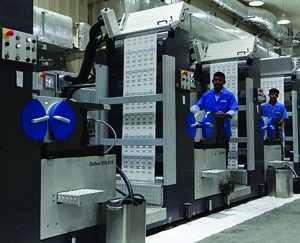After firing up its new Gallus ICS 670 press for manufacturing folding cartons, Al Mawrid Printing has gained in jobs as well as efficiency, says General Manager T K Babukutty.
The press was chosen for printing cigarette packets as well as food and cosmetics packaging following the emergence of ‘high-def’ flexo, he told Packaging MEA.
“As demand for cigarette packs increased in volume, we began to find that traditional methods of production on the offset presses and die-cutters became less economic, and decided that if we were to develop our business in this product sector we needed to invest in a new type of technology,” he said.

While top cigarette brands were using rotogravure, Al Mawrid decided after meeting press manufacturers that its customers’ work needed offset for half-tones and graphics.
Five years ago, the firm discussed flexo/gravure combos with Gallus, but flexo print quality was not yet up to customers’ expectations, said Babukutty.
“Once the flexo print quality issue was resolved we knew that inline production was the right way to go for cigarette packs. We agreed to buy the Gallus ICS 670 press that was exhibited at Drupa 2012.”
Al Mawrid’s production is now largely packaging, a reversal of its focus on commercial print until recent years. The company runs 10 Heidelberg sheetfed presses ranging from single-colour small format up three B1 Speedmasters.
The Gallus line, purpose built for Al Mawrid, stretches more than 50 metres, and is configured with an automated reel unwind, a web cleaner, two units for cold foil or laminate application (or flexo printing), two gravure units, six flexo print stations, flatbed die cutting, and a blank separating unit with a shingle delivery.
Valued at about €4.5m, the new Gallus’s top mechanical speed is more than 200m/min. Ten weeks into commercial production, the press regularly runs at about 180m/min on a double day shift.
With cold foiling, the speed is about 150m/min, said its operators.
These speeds are being achieved on carton boards of 200–250gsm, although Gallus claims the press can handle 600gsm.
Babukutty said the Gallus delivers high quality print with both UV- or water-based flexo inks.
In fact, his firm has received complaints over the improvement in print quality, which in some markets raises concerns the cigarettes are fakes.
Securing new work for the press normally entails some print sampling, followed by a limited run of perhaps 500,000 cartons for test marketing, then a print run that can run into many millions.
Al Mawrid has seen commercial run lengths from 100,000 up to 10 million, with a trend towards narrow packs for slimmer ‘nano’ cigarettes.
The gravure units are used on about 20–25% of jobs, mainly for metallics and special colours.
“They offer us production flexibility and the capacity to add value, but I do not foresee any significant increase in demand for gravure printing, and we would be unlikely to specify them on any future investment,” said Babukutty.
The Gallus is used mainly for tobacco products and cosmetic cartons. Some customers still specify offset printed cartons, made with Speedmasters and Bobst die-cutters.
Al Mawrid uses its sheetfed capacity where no added value is required or price is a major issue.
“Ideally, we need to run the Gallus 24 hours a day for it to be at its most cost-effective. Makeready and waste on a press of this length support medium to long runs with embellishment, and our plan is to schedule two or three days continuous running on one job.”



